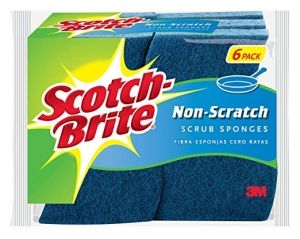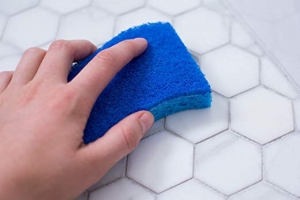
Our Top Rated Multi Purpose Sponge
When Choosing The Best Sponge
There are many objects in everyday life today that are simply part of it and are taken for granted. However, these are actually anything but self-evident and would be missing very quickly if not longer available. A very good example of such an item is a sponge. Most people use it every day in the kitchen to effectively remove dirt from the dishes. But actually a sponge is much more than a simple utensil in the kitchen and of course also offers much more features. In addition, there are many different models, which of course not all are well suited for all applications and requirements. So what is there to consider when using, what special features are there? How to choose the best sponge used?
A good quality multi purpose sponge is an essential cleaning tool in the household and that’s why we have chosen the Scotch-Brite Non-Scratch Scrub Sponge as our Hot Pick for the best all purpose sponge.
Features:
Non-scratch scouring pad cuts through messes while protecting your surfaces
Scouring pad on one side and absorbent sponge on the other for multiple uses
Durable materials stand up to stuck-on grime
Scotch-Brite Brand is the #1 selling scrub sponge brand
Safe for all cookware
Backed by the power of 3M Science
… Scotch-Brite Non-Scratch Scrub Sponge means no worries, no scratches, no excuses! It wipes away messes from nonstick cookware, countertops or any other surface with a finish you don’t want to scratch. And, its wavy shape is comfortable to hold. Just sanitize in the dishwasher and reuse! …
How Did We Test?
By Ourselves
What Did We Test?
Handling, Usability, Absorbing Capacity, Abrasion
Where Did We Test?
Cookware, Tiles, Sink, Windows
What’s Hot, What’s Not?
Handling ♥♥♥♥♥
Usability ♥♥♥♥♥
Absorbing Capacity ♥♥♥♥♥
Abrasion ♥♥♥♥♥
Price ♥♥♥♥♥
Environmental Compatibility ♥♥
Overall Price Quality Ratio
♥♥♥♥♥
Our product of choice the Scotch-Brite Non-Scratch Scrub Sponge, 6-Sponges is available on amazon
What We Ever Wanted To Know About Sponges
Long before the time of synthetic products and artificial sponges, natural sponges of the sea were used by ancient Egyptians, Greeks and Romans, as well as many other peoples of the Caribbean and the Mediterranean.
Over time, through trade and exploration, these versatile wonders of the sea have become popular throughout Europe and the western world, and then replaced by synthetic products in modern times. To whom exactly the invention of the modern household sponge is attributed, is unclear.
What Should Be Considered When Using A Sponge?
When using a sponge, hygiene should always be in the foreground. Because the results of a recent study are actually frightening. According to this, in an average sponge in the kitchen, which is of course also used regularly, more bacteria than in a public restroom. Since dishes and cutlery are to be cleaned with the contaminated sponges, this is a not to be underestimated danger. However, this danger can of course be significantly reduced with proper handling. Accordingly, care should be taken that the sponge is thoroughly rinsed with as hot water as possible after each use. After vigorous pressing, storage is best done in a relatively dry environment to reduce germ multiplication to an absolute minimum. Of course, it is also very important to change the sponge accordingly. At least every week, the old specimen should either migrate into the residual waste and be replaced with a new one or, if possible sanitized in the dishwasher before reused. The actual interval for a necessary change, of course, depends primarily on the use and frequency of use, so these are only approximate numbers.
What Makes A Sponge A Good Sponge?
Exquisite choice of material: durable materials for multi purpose use but which withstand at all loads and does not scratch
Good Absorbing Capacity: the absorbing capacity is an important matter for a good quality sponge
Dishwasher Suitability: a sponge which can be put into the dishwasher can be sanitized properly and therefore used more often before going to be wasted


